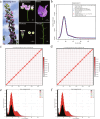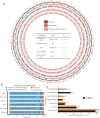Chromosome-level and haplotype-resolved genome assembly of Bougainvillea glabra
- PMID: 39827170
- PMCID: PMC11742905
- DOI: 10.1038/s41597-024-04333-6
Chromosome-level and haplotype-resolved genome assembly of Bougainvillea glabra
Abstract
Bougainvillea glabra Choisy, a common perennial shrub or climbing vine in tropical and subtropical areas, has significant ornamental and ecological value due to its showy floriferous blooms and adaptability to multiple environmental stresses. In this study, based on PacBio and Hi-C sequencing data, we presented the haplotype-resolved, and chromosome-level assembled genomes for B. glabra (2n = 34). We obtained two haplotypes with genome size of 2,855,692,602 bp and 2,889,511,499 bp, N50 of 165 Mbp and 167 Mbp, and both anchored to 17 chromosomes with anchor ratio of 97.07% and 97.55%, respectively. Through the BUSCO evaluation process, the two assembled haplotypes both exhibited the high score of 96%. By combining the high-confidence different evidence of genome structure annotation pipeline we annotated each haplotype containing ~33,000 predicted genes, of which 86% were functionally annotated by different databases. These high-quality haplotypes assembly and annotation results will serve as a great genomic resource to explore the ornamental traits and environmental adaptability and accelerate improvement in future.
© 2025. The Author(s).
Conflict of interest statement
Competing interests: The authors declare no competing interests.
Figures


References
-
- Roy, R. & Singh, S. History of migration. Chronica Horticulturae56, 10 (2016).
-
- Sindhu, S., Singh, B. & Saxena, N. Genetic improvement of bougainvillea in Indian scenario-A review. Journal of Ornamental Horticulture23, 1–11 (2020).
-
- Salam, P., Bhargav, V., Gupta, Y. & Nimbolkar, P. Evolution in bougainvillea (Bougainvillea Commers.)-a review. Journal of Applied and Natural Science9, 1489–1494 (2017).
-
- Jain, G. & Gould, K. S. Are betalain pigments the functional homologues of anthocyanins in plants? Environmental and Experimental Botany119, 48–53 (2015).
-
- Timoneda, A. et al. The evolution of betalain biosynthesis in Caryophyllales. New Phytologist224, 71–85 (2019). - PubMed
Publication types
MeSH terms
LinkOut - more resources
Full Text Sources
Miscellaneous

